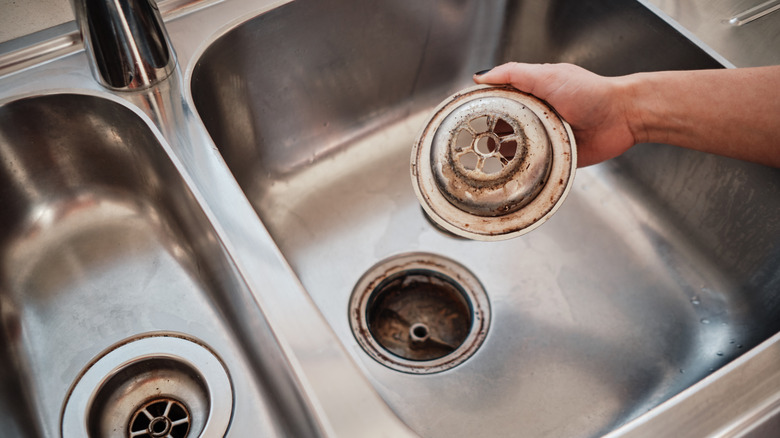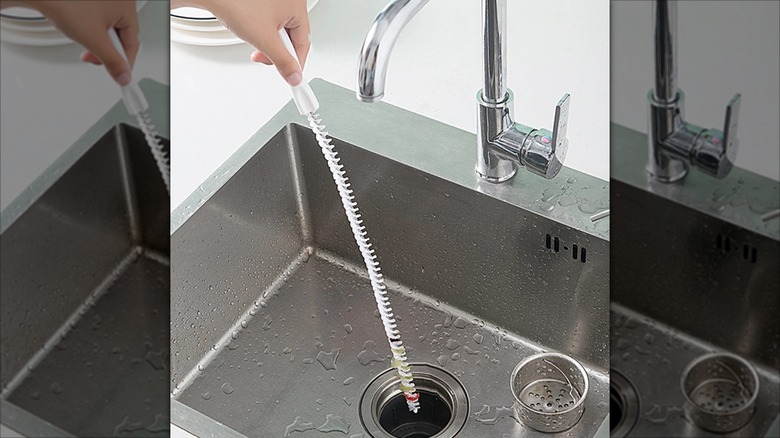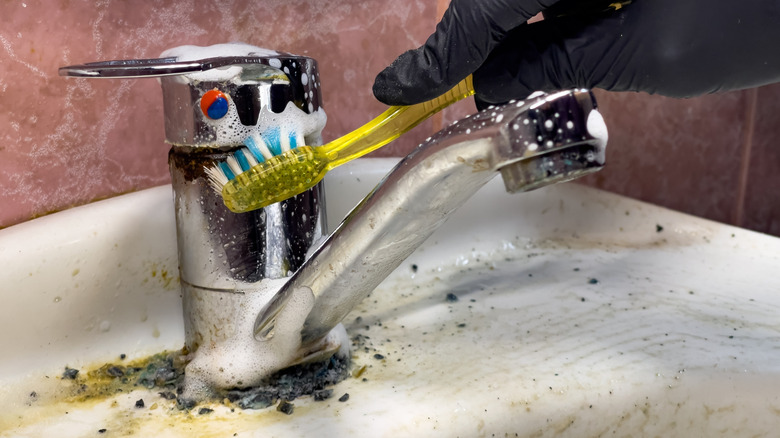The One Tool Pros Use To Get Sink Drains (And Faucets) Sparkling Clean
We may receive a commission on purchases made from links.
Is there a weird smell coming out of your sink? Is it clogged? Have you poured every cleaning product you can get your hands on down the drain, but nothing seems to work? According to Kathy Cohoon, Operations Manager at Two Maids, it's probably time to use a flexible drain cleaning brush. There's not a household out there that isn't constantly rinsing dirt, grime, toothpaste, hair, and other who-knows-what right down the drain. Even if your sink isn't totally clogged up and water still drains out, over time the gunk buildup can start to grow bacteria that leads to foul odors. There's more to cleaning your drains than just getting rid of the stench. Regularly removing this stinky buildup with a flexible drain brush can help to prevent mold and mildew growth that's harmful to your health, and corrosion and leak repairs that will hurt your pockets.
"A flexible drain brush is a great tool for keeping sink drains clear of hair, grime, and other debris that can lead to clogs," Cohoon told House Digest during an exclusive interview. "It's an inexpensive and effective way to maintain your drains without relying on harsh chemicals." Caustic chemical cleaners can wreak havoc on your pipes and contaminate your local water supply, making them among the worst ways to clean your sink drain. While there are several different options out there, thousands of Amazon customers have given the Desin Nylon Double Ended Flexible Drain Brush a five-star rating. Cohoon told us that along with being an affordable tool, flexible drain brushes are "easy to use and effective for routine cleaning."
How to use a flexible bristle brush to clean your drain
Although getting rid of strange smells and clogs can be an unpleasant process, a flexible bristle brush is a great way to get the job done. "Start by removing the drain stopper — it's often coated in buildup, so keep some cleaning spray nearby to wipe it down," Kathy Cohoon suggested during her exclusive interview with House Digest. "Next, gently insert the brush into the drain, twisting and moving it up and down to dislodge and grab any trapped hair or debris," Cohoon said. Adding some cleaning solution is totally optional, but may help to loosen some of the grime. The cleaning expert explained that after you dislodge clogged material, you should gently pull the brush out of the drain and remove the buildup. Don't forget to wear gloves! Then, repeat the process until the pipe is unclogged.
We asked Cohoon how often our readers should use a flexible bristle brush, and were surprised by her answer. "For best results, use a drain brush as part of your regular cleaning routine," she advised. "Weekly use is ideal for high-traffic areas like bathroom sinks, but even cleaning once a month can prevent major plumbing problems down the road," Cohoon added. The cleaning expert also recommended a few other steps for ongoing drain maintenance. "A natural solution like baking soda followed by vinegar is a great option for deodorizing and preventing buildup," she said. Cohoon also suggested using a drain screen like the top-rated LASSHSWA Stainless Steel Sink Strainer from Amazon to keep debris out of your drain altogether.
A smaller brush is ideal for cleaning other hard-to-reach areas
Although a flexible drain brush set is relatively affordable, you'll be glad to know the tool can do double-duty when it's time to clean. "While it's best to reserve one brush specifically for your drains, a second flexible brush can be useful for a variety of other household cleaning tasks," Kathy Cohoon told House Digest during her exclusive interview. She said that you can use the tool for cleaning between keyboard keys, under appliances that collect dust, and in other hard-to-reach spots. "Its slim, flexible design makes it ideal for reaching into places that traditional brushes can't," she explained.
Cohoon recommended picking a flexible drain brush that can be gently bent to get into awkward areas. But she cautioned that you should "choose a brush that returns to its original straight shape afterward, since you'll want it straight for drain cleaning." You'll need to use a light touch when maneuvering the brush so it doesn't get hopelessly bent out of shape, and you should frequently wipe away the debris it picks up.
There's another tool Cohoon likes even better for getting rid of gunk around your faucet. "A small handheld detail brush or an old toothbrush can work well in tight spaces where a drain brush might be too bulky," she said. "These tools let you scrub directly at the buildup and reach narrow crevices." That's just one of the brilliant ways to use a toothbrush around the house. They're also great for cleaning dirty vents and blinds.


